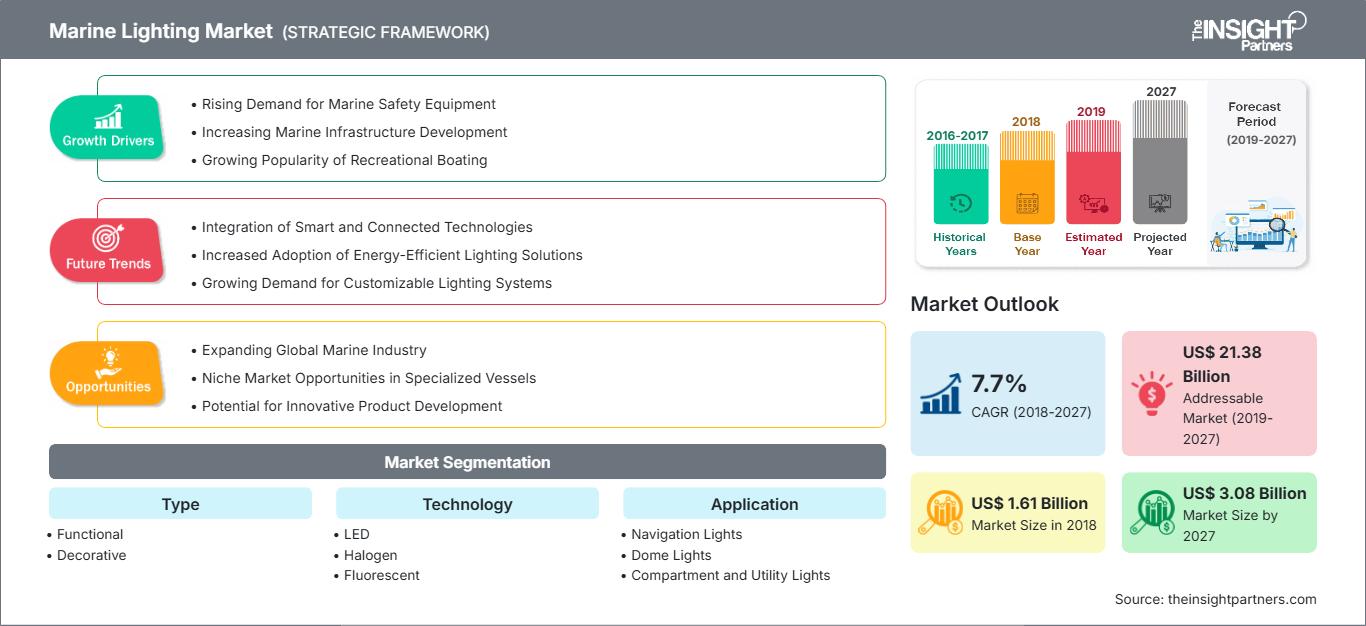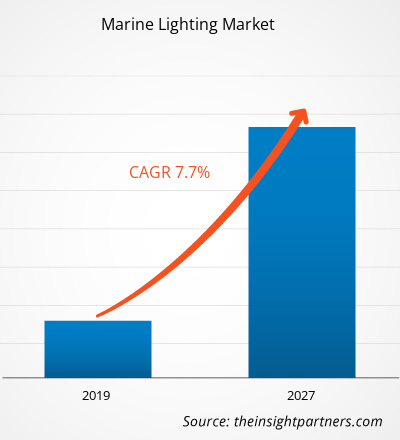Il mercato globale dell'illuminazione navale ha rappresentato 1.611,96 milioni di dollari nel 2018 e si prevede che raggiungerà i 3.083,73 milioni di dollari entro il 2027, con un tasso di crescita annuo composto (CAGR) del 7,7% durante il periodo di previsione.
L'APAC ha guidato il mercato dell'illuminazione navale grazie alla presenza di una solida industria cantieristica, con Cina, Corea del Sud e Giappone come tre nazioni cantieristiche a livello mondiale. Altri fattori, come l'aumento del commercio globale e le normative marittime, hanno generato la domanda di navi commerciali, che a sua volta ha portato alla crescita del mercato dell'illuminazione navale. Si prevede che la Cina detenga la quota maggiore del mercato dell'illuminazione navale grazie alla presenza di una solida industria cantieristica commerciale, come navi cargo e petroliere. Inoltre, la Corea del Sud sta assistendo a una forte domanda da parte del mercato globale di navi GNL. Anche altre economie in via di sviluppo nella regione APAC stanno assistendo a una forte crescita nei loro settori della costruzione e della riparazione navale. Inoltre, le economie sviluppate di tutto il mondo stanno notando un'elevata necessità di ammodernamento delle loro flotte obsolete, dando così impulso al mercato dell'illuminazione marina.
Personalizza questo rapporto in base alle tue esigenze
Potrai personalizzare gratuitamente qualsiasi rapporto, comprese parti di questo rapporto, o analisi a livello di paese, pacchetto dati Excel, oltre a usufruire di grandi offerte e sconti per start-up e università
Mercato dell'illuminazione marina: Approfondimenti strategici

-
Ottieni le principali tendenze chiave del mercato di questo rapporto.Questo campione GRATUITO includerà l'analisi dei dati, che vanno dalle tendenze di mercato alle stime e alle previsioni.
Approfondimenti di mercato: l'aumento delle attività di costruzione navale stimola la domanda per il mercato dell'illuminazione navale
Le attività di costruzione navale sono in crescita in tutto il mondo, soprattutto in mercati come Cina e Stati Uniti, a causa del crescente numero di viaggiatori e delle attività commerciali. Si prevede che l'aumento delle attività di costruzione navale in tutto il mondo influenzerà positivamente la crescita delle soluzioni di illuminazione navale. La crescita delle attività commerciali via mare in tutto il mondo, dovuta alle sane relazioni commerciali, è un altro fattore che alimenta l'industria cantieristica, il che si tradurrà in un aumento della domanda di soluzioni di illuminazione navale.
La crescente adozione di soluzioni di illuminazione a LED offre un'opportunità redditizia per il mercato dell'illuminazione navale
Gli armatori stanno installando soluzioni di illuminazione a LED per ridurre il consumo energetico e i costi operativi della nave. Le soluzioni di illuminazione a LED sono anche meno vulnerabili ai danni causati dall'acqua; pertanto, vengono utilizzate nelle lampade subacquee. Il mercato dell'illuminazione marina sta attraversando un'evoluzione dalle tecnologie di illuminazione tradizionali a soluzioni di illuminazione a LED basate sulle esigenze dell'utente, creando una forte domanda di soluzioni di illuminazione marina a LED.
Approfondimenti sulle tipologie
Il mercato globale dell'illuminazione marina, per tipologia, è stato segmentato in luci funzionali e luci decorative. Le luci funzionali forniscono l'illuminazione necessaria per svolgere varie operazioni e garantire la sicurezza dell'imbarcazione, mentre le luci decorative contribuiscono a migliorare l'atmosfera della nave. Il crescente numero di navi commerciali è un fattore significativo che guida la crescita del mercato dell'illuminazione marina funzionale. Tuttavia, la crescente popolarità dei veicoli di lusso è il fattore principale che guida la crescita del mercato dell'illuminazione marina decorativa.
Approfondimenti sulle applicazioni
Nel 2018, il mercato globale dell'illuminazione marina per applicazione è stato guidato dal segmento compartimenti e servizi. Quando si opera su un'imbarcazione di notte, è fondamentale per gli operatori mantenere la capacità di vedere sotto i piedi, senza perdere la visione notturna a causa di un forte riverbero luminoso. Pertanto, l'illuminazione di servizio è necessaria per illuminare le aree del ponte e i corridoi, migliorando la sicurezza e l'atmosfera generale dell'imbarcazione. Inoltre, le luci di servizio per imbarcazioni possono aiutare a dirigere la luce verso aree precise che richiedono particolare attenzione.
Approfondimenti per l'utente finale
Il mercato globale dell'illuminazione marina, in base all'utente finale, è segmentato in navi commerciali, navi passeggeri e altre. Nelle navi commerciali, le soluzioni di illuminazione svolgono un ruolo importante nella navigazione, nella sicurezza e nelle operazioni. Nelle navi passeggeri, il design delle soluzioni di illuminazione deve adattarsi al design interno ed esterno della nave per creare un'atmosfera gradevole. Le soluzioni di illuminazione marina sono note per il loro elevato consumo energetico. Pertanto, si sta verificando uno spostamento dell'attenzione verso l'adozione di soluzioni a risparmio energetico tra i segmenti di utenti finali. Si stima che il mercato dell'illuminazione marina, per utente finale, sarà dominato dalle navi commerciali per tutto il periodo di previsione.
Mercato dell'illuminazione marinaLe tendenze regionali e i fattori che influenzano il mercato dell'illuminazione marina durante il periodo di previsione sono stati ampiamente spiegati dagli analisti di The Insight Partners. Questa sezione illustra anche i segmenti e la geografia del mercato dell'illuminazione marina in Nord America, Europa, Asia-Pacifico, Medio Oriente e Africa, America Meridionale e Centrale.
Ambito del rapporto sul mercato dell'illuminazione marina
| Attributo del rapporto | Dettagli |
|---|---|
| Dimensioni del mercato in 2018 | US$ 1.61 Billion |
| Dimensioni del mercato per 2027 | US$ 3.08 Billion |
| CAGR globale (2018 - 2027) | 7.7% |
| Dati storici | 2016-2017 |
| Periodo di previsione | 2019-2027 |
| Segmenti coperti |
By Tipo
|
| Regioni e paesi coperti |
Nord America
|
| Leader di mercato e profili aziendali chiave |
|
Densità degli operatori del mercato dell'illuminazione marina: comprendere il suo impatto sulle dinamiche aziendali
Il mercato dell'illuminazione nautica è in rapida crescita, trainato dalla crescente domanda degli utenti finali, dovuta a fattori quali l'evoluzione delle preferenze dei consumatori, i progressi tecnologici e una maggiore consapevolezza dei vantaggi del prodotto. Con l'aumento della domanda, le aziende stanno ampliando la propria offerta, innovando per soddisfare le esigenze dei consumatori e sfruttando le tendenze emergenti, alimentando ulteriormente la crescita del mercato.

- Ottieni il Mercato dell'illuminazione marina Panoramica dei principali attori chiave
Le soluzioni di illuminazione marina fornite dai vari operatori variano in base alle dimensioni dei fornitori e alla loro capacità di produrre hardware. Di seguito sono elencati alcuni degli sviluppi recenti:
- 2019: R. STAHL TRANBERG ha lanciato la serie di illuminazione TRANBERG BlueLine. Si tratta di una gamma completa di illuminazione di nuova generazione, economica e di alta qualità per il settore marittimo.
- 2018: Hella ha presentato le lampade a LED Sea Hawk 470, adatte per l'illuminazione di ponti e passerelle a bordo di navi e altre applicazioni correlate.
- 2017: ITC ha introdotto VersiControlTM, un sistema di controllo dell'illuminazione RGB per il settore marittimo. La soluzione offre la possibilità di controllare individualmente l'illuminazione con un pannello di controllo a 4 zone all-in-one e/o un'app per smartphone.
ILLUMINAZIONE MARINA GLOBALE - SEGMENTAZIONE DEL MERCATO
Per tipologia
- Funzionale
- Decorativa
Per tecnologia
- LED
- Alogena
- Xenon
- Fluorescente
Per Applicazione
- Luce di navigazione
- Dome Light
- Luce di sicurezza
- Luce per vano e servizi
- Luce di attracco
- Altro
Per utente finale
- Nave commerciale
- Nave passeggeri
- Altro
Per Geografia
-
Nord America
- Stati Uniti
- Canada
- Messico
-
Europa
- Francia
- Germania
- Regno Unito
- Italia
- Russia
- Resto d'Europa
-
Asia Pacifico (APAC)
- Australia
- Cina
- Corea del Sud
- India
- Giappone
- Resto dell'APAC
-
Medio Oriente e Africa (MEA)
- Arabia Saudita
- Sudafrica
- Emirati Arabi Uniti
- Resto del MEA
-
Sud America (SAM)
- Brasile
- Argentina
- Resto del SAM
Profili aziendali
- DRSA
- Gruppo ENSTO
- HELLA GmbH & Co. KGaA (Hella Marine)
- Illuminazione innovativa
- ITC Marine
- Lumiron, Inc
- Lumitec LLC.
- NJZ Lighting Technology Co., Ltd
- Phoenix Products LLC
- The Carlisle & Finch Co
Altri attori del mercato della catena del valore:
Hangzhou Jaiwill Technology Co., Ltd., Signify, KOITO MANUFACTURING CO., LTD, Osram GmbH, TACO Marine e Foresti & Suardi sono alcuni altri attori del mercato della catena del valore che non sono descritti nel rapporto e possono essere inclusi su richiesta.
- Analisi storica (2 anni), anno base, previsione (7 anni) con CAGR
- Analisi PEST e SWOT
- Valore/volume delle dimensioni del mercato - Globale, Regionale, Nazionale
- Industria e panorama competitivo
- Set di dati Excel
Report recenti
Rapporti correlati
Testimonianze
Motivo dell'acquisto
- Processo decisionale informato
- Comprensione delle dinamiche di mercato
- Analisi competitiva
- Analisi dei clienti
- Previsioni di mercato
- Mitigazione del rischio
- Pianificazione strategica
- Giustificazione degli investimenti
- Identificazione dei mercati emergenti
- Miglioramento delle strategie di marketing
- Aumento dell'efficienza operativa
- Allineamento alle tendenze normative






















 Ottieni un campione gratuito per - Mercato dell'illuminazione marina
Ottieni un campione gratuito per - Mercato dell'illuminazione marina